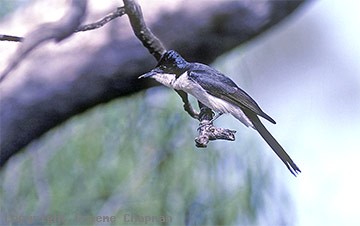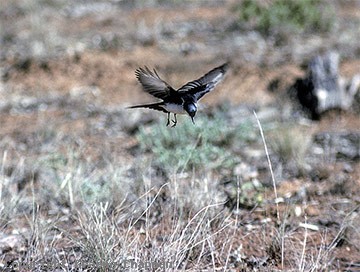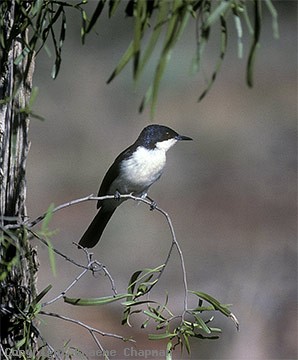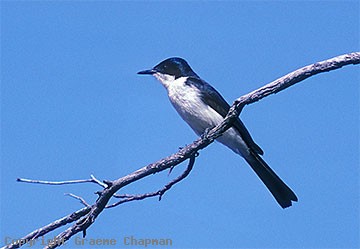
Some people do confuse Restless Flycatchers with Willie Wagtails - the two are both basically black above and white below, but the Willie Wagtail has a black throat - that's one obvious difference, however a few moments spent watching their behaviour will reveal a lot more. Restless Flycatchers at rest have their tail pointing downwards and occasionally waggle it from side to side, a habit they share with some other members of the genus Myiagra - the Leaden, Satin and Broad-billed Flycatchers. Conversely, Willie Wagtails hold the tail erect and fan it often, because they are a fantail and belong to the genus Rhipidura along with the Grey and Rufous Fantails. Restless flycatchers also share with some other Myiagra flycatchers the ability to erect the crown feathers into a short crest when excited (see pic 369201) - their main territorial songs are also very similar.
Restless Flycatchers are inhabitants of open woodland and semi-arid shrublands - you won't often find them in dense forest or rainforest. In northern Australia a very similar species (or subspecies, depends on which book you refer to), the Paperbark Flycatcher is found mainly along streams amongst paperbark (Melaleuca) woodland and associated vegetation (see under Paperbark Flycatcher). These closely related forms have much in common, perhaps the most distinctive habit being one of their methods of feeding - they hover a metre or two above the ground,( see pic 369202) all the while uttering a peculiar harsh call which sounds for all like white noise (listen on sound page), or to some old timers, like the grinding of scissors, hence the alternative common name. I am of the opinion that this sound is actually being used to disturb their prey - I have seen a Scissors Grinder uttering the call with the mouth wide open and "spraying" the sound from side to side and on one occasion in western NSW saw two birds catching scorpions. Now scorpions normally rest well below the entrance to their burrows during the day and the inference is that the grinding sound may disturb them.
Adult male and female Restlesss Flycatchers are very alike (females have grey lores see pic # 369214D), but younger birds usually have some pale rufous colouration on the throat. There are many records of pairs of birds nesting in the same place year after year with the resultant suggestion that they are resident, but in other areas they seem to be present for only part of the year and that they are nomadic or even migratory, but no clear patterns are evident.




